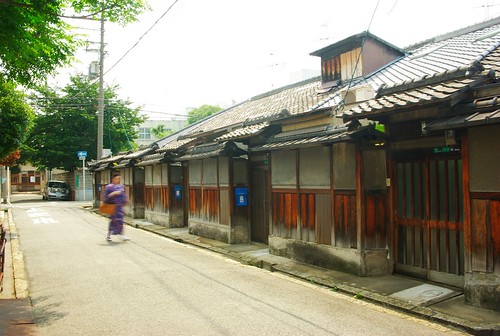The climate and the geology here is hard on buildings, with typhoons, hot, humid weather, floods, landslides, earthquakes and so on. The climate and resources also dictate light wooden buildings rather than stone; the islands are volcanic, so there's a relative lack of hard stone good for building, and stone buildings are susceptible to earthquake damage.
And as buildings just weren't expected to last all that long anyway, there was little point in wasting effort and material to overdesign them. Make it last for a generation or two instead, and let people rebuild from time to time. Even temples and shrines sometimes schedule a periodic tear-down and rebuild of their halls.
A peculiarity of the throw-away mentality is that many houses have serious brick or tile facades only toward the street. Out the back they're completely plain, even unfinished-looking.
Today we can make buildings that last longer, but the idea that old houses - single-family homes especially - are near worthless lives on. The land is everything and the building on it is generally worth nothing at all unless near-new. In fact, old buildings may actually detract from the land price since the new owner will have to pay to tear it down.
And since you won't get your money back if you build to last, people usually don't. So you get family homes and apartments with badly insulated paper-thin walls and single-pane windows, no central heating, creaky floors, dingy fake wood paneling and cheap-looking facades. Buildings that naturally are nearly worthless after thirty years, further reinforcing the idea that old buildings are no good.
If a few far-sighted people started building for the long term, attitudes could change of course. But they'd be just one unfortunate landslide or earthquake away from looking less like visionaries and more like wasteful dunces.




Lovely job again Janne. It's funny though, Our Man hears this "Japan is a land of earthquakes so don't build for the long term" refrain alot yet just down the road there are traditional farmhouses that have been here for 100 years or more, so it's how you build that counts, methinks.
ReplyDeleteOur Man's gunning for Hitchcock, not Bergman, anyways!
A century of the same living home sounds long for rural buildings here. Note that while the owners may state the house has been there for a century, it doesn't mean it's been the same actual, physical building all that time. There may be little left of the original building apart from the main frame by now. It's like those temples many hundreds of years old where no physical building is actually older than a century.
ReplyDeleteI talked to a farmer about this a few years ago (I was living out in the middle of nowhere, relatively speaking) and he said living houses generally lasted 60-80 years or so before they needed to be rebuilt. Accessory buildings could last longer - and in his family's case they'd once actually converted the second home (used by the then grand parents) to storage, while the old storage was torn down and rebuilt as the new second home.
Hitchcock shows you people dying; Bergman makes you want to die. I like that audience particpation aspect :)
Great stuff as usual. Agree with much of what you say. I've posted some thoughts on the subject here: http://www.yumejistheme.com/blog/2009/8/3/quality-housing.html
ReplyDeletecheers Janne,that's a fascinating post.really,I'm amazed.I jsut can't conceive of it.in the UK,they are worth more,the older they are generally!!!
ReplyDeleteActually, Kildare, wasn't London much like that at one time, with lots of cheap wooden buildings? I vaguely remember hearing that a law was passed after the great fire that specifically forbade wood and thatch constructions within city limits.
ReplyDeleteThis "it's old so it must be good" attitude is pretty recent. I heard that in Stockholm's Old Town, where houses typically are 3-600 years old, plots were sold for a pittance in the late 1950's. The area was pretty seedy and worn at the time, and laws were passed requiring owners to maintain and restore the old buildings. Many owners preferred to dump them at whatever cost rather than spend a small fortune on restoration and maintenance. Of course, those that did spend the funds has made back that money many, many times over by now...